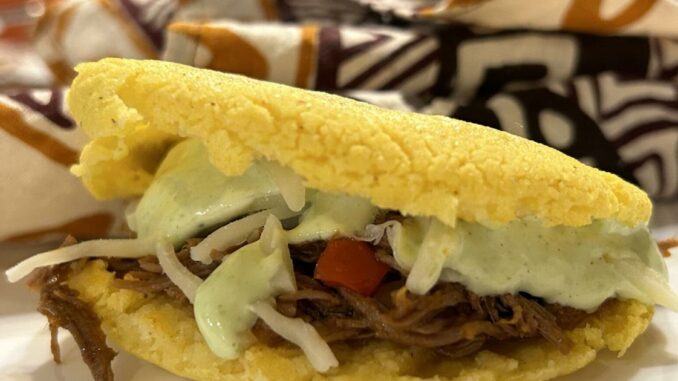
When David Gomez left his home in Venezuela for college, he packed an electric arepa maker to ensure he would eat well while studying at the University of Louisiana at Lafayette. Arepas, a beloved, belly-filling Venezuelan food, are hand-sized toasted cornmeal patties, typically split and filled with savory deliciousness.
In 2001, I taught English classes to Gomez in some of his early semesters at UL. I assigned a cooking demonstration as a final class project. Gomez brought a tiny electric skillet and prepared arepas, the much-loved Venezuelan delicacy.
He made an A.
David Gomez checking arepas.
A couple of decades later, with our kids at the same school and his wife working as a fellow writer, our paths crossed again. I was invited to their home in Youngsville for another arepas-making session — no grade involved this time.
Gomez’s cooking repertoire has much expanded, thanks to years of cooking for his family and living in various parts of the world working in his work as a petroleum engineer. Going beyond the simplicity of his college days, he prepared shredded beef and chicken, plus his secret-recipe garlic sauce, in addition to the arepas.
“Arepas are good anytime — breakfast, lunch, dinner and especially after staying out late,” Gomez said, noting that you can stuff them with almost anything savory.

At the Table 3.10.24 David Gomez hand mixes dough for arepas.
When his work brought him and his family to live in Argentina for a few years, they fell into a rhythm of barbecuing on the weekends and enjoying the leftover meat with arepas for Sunday brunch. No leftover barbecue? Scrambled eggs, avocado, sausage, cheese and whatever is in the fridge will all taste better stuffed into a warm arepa, with one exception: no sweets. Keep it savory. Put down the Steen’s cane syrup. This is not your grandma’s couche-couche.
The recipe for arepas, which includes corn, water and salt, dates to more than 2,000 years ago, originating among the Indigenous peoples of the northern regions of present-day South America. The process originally involved drying fresh corn, cooking it, mashing it and then drying the mash into flour before making the arepas to be cooked over a fire.
Since nobody in modern times seems to have time for all that drying and mashing, the continuation of the recipe is often credited to the invention of a packaged, pre-cooked cornmeal by Luis Caballero Mejías, a Venezuelan who earned patent 5176, based on experiments he had carried out to industrialize the production of corn dough.

At the Table 3.10.24 David Gomez shaping arepas.
The product hit the product in 1960 under the brand name P.A.N., Productos Alimenticios Nacionales or National Food Products (pan also being the Spanish word for bread.)
The recipe for arepas can be found on the PAN packaging but working alongside Gomez, who grew up cooking with his mother and sisters, I learned a few tricks you won’t find on the back of the bag: Use your hands. Adjust for toastiness and listen.
Eschewing a spoon, Gomez gently dug his hands into the vivid, yellow cornmeal mélange which allowed him to feel and break up any clumps that formed while slowly mixing until something akin to playdough formed. When cooking the arepas in the pan, he regularly checked for browning to occur — the relative darkness being somewhat a personal preference (make mine extra toasty, please), but also affected by the level of heat which should be adjusted as necessary to ensure doneness throughout.

At the Table 3.10.24 David Gomez hand mixes dough for arepas.
After finishing his arepas in the oven, Gomez gave each a gentle thwack — a lower sound being indicative of a hollowness that forms in the center when they are ready to be taken out.
Serving arepas hot is key to their deliciousness and to melt the butter, a well-loved filling in the Gomez household. Stuffed with carne mechada and mozzarella cheese (a good substitute for Venezuelan cheese according to Gomez), the arepa becomes a meal. Despite his refusal to share the recipe for the light green garlic sauce, Gomez entertained my guesses at the ingredients beyond the obvious garlic — Mayo? Cilantro? Lime juice?
I slathered it on, then added more after each bite. Whatever the ingredients, the garlic sauce took the meal from an A to an A++.

At the Table 3.10.24 David Gomez kneading dough for arepas.
Beef Carne Mechada
Serves 8-12
Recipe by David Gomez
For the broth:
half to 1 whole onion, chopped
2 stalks celery, chopped
1 carrot, halved
1/4 cup cilantro
Salt and black pepper to taste
2 1/2 – 3 pounds skirt or flank steak
For the meat mixture:
2 tablespoons vegetable oil
1 onion, chopped
1 green bell pepper, chopped
1 red bell pepper, chopped
1 bay leaf
2 cloves garlic, chopped
4 1/2 ounces tomato paste
2 teaspoons cumin
1/2 teaspoon paprika
1 cup broth, divided
Salt and black pepper to taste
1. Combine all ingredients for the broth in a Dutch oven. Add enough water to completely cover the meat and vegetables.
2. Bring to a boil, cover, and let simmer on low for 1 1/2 to 2 hours.
3. Remove from heat to cool slightly.
4. Drain and reserve resulting broth. Discard cooked vegetables and set aside meat.
5. Once meat is cooled enough to handle, shred and reserve.
6. Heat vegetable oil over medium to high heat. Add onions and stir until they become translucent and start to brown.
7. Add bell peppers and sauté until wilted.
8. Add bay leaf and garlic. Sauté briefly.
9. Stir in tomato paste and continue to sauté over medium heat.
10. Stir in cumin and paprika until a fond forms or the grimilles stick to the bottom.
11. Deglaze the pan with 1/4 cup of reserved broth.
12. Add salt and black pepper to taste, then stir in an additional 1/4 cup broth.
13. Add shredded meat, stir, then add an additional 1/2 cup broth.
14. Taste and adjust seasonings. Lower heat and simmer until thoroughly heated.
Arepas
Serves 8.
Recipe by David Gomez
3 cups water
1/2 teaspoon salt
2 3/4 cup pre-cooked yellow cornmeal (PAN is a common brand available at most Hispanic grocery stores)
Vegetable oil
1. Preheat oven to 325 degrees and wash hands.
2. In a medium-sized bowl, dissolve salt in the water.
3. Add cornmeal and mix with your hands, breaking apart any lumps that might have formed.
4. Mix until a soft ball of dough forms.
5. Let rest for 2-3 minutes.
6. With wet hands, knead the dough for 2-3 minutes.
7. Heat skillet on low to medium heat. Coat the skillet with a scant amount of vegetable oil.
8. Divide dough into 8 equal-sized lumps. With each lump, form a round patty-shaped arepas about half-inch thick and about 4 inches across.
9. Cook each arepas approximately 5 minutes per side, until slightly toasted, or to your preference.
10. Place skillet toasted arepas on a pan and finish cooking in the oven for 10 minutes at 325 degrees.
11. Serve hot. Let guests slice and fill each with carne mechada and condiments such as butter, garlic sauce, mozzarella cheese and hot sauce.



Leave a Reply